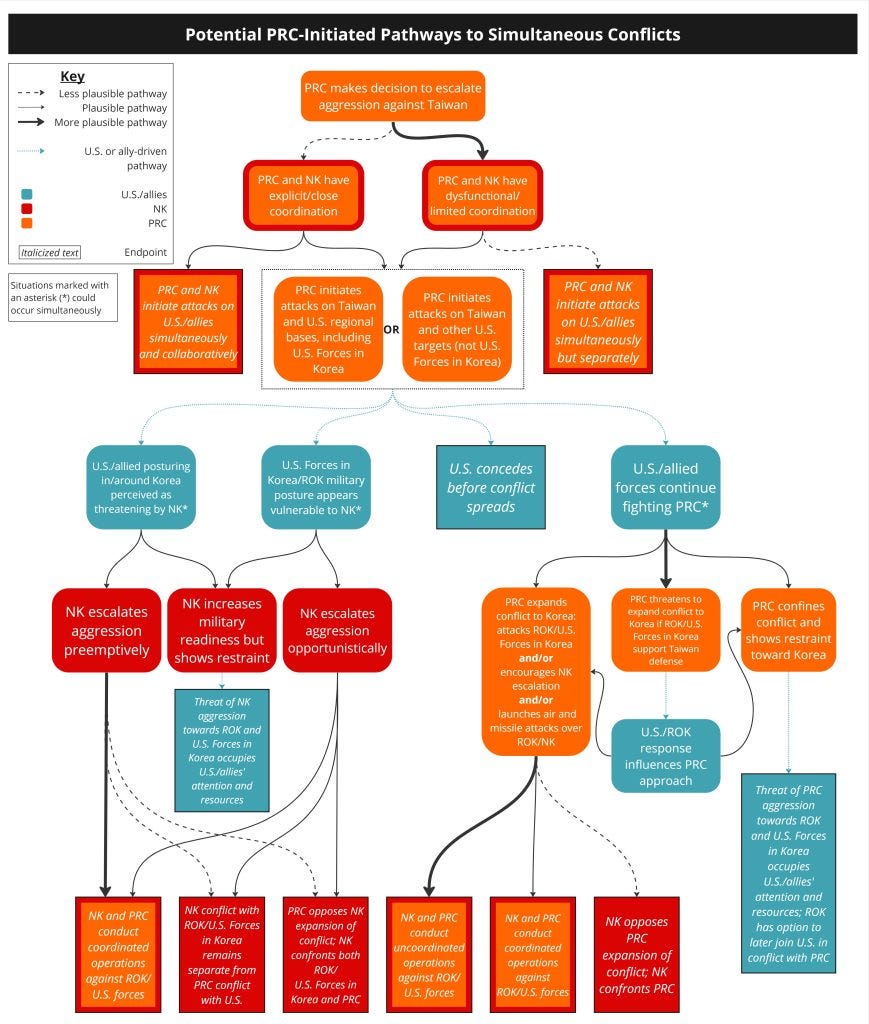Quick Tanks: The Best of Long-Form Defense Analysis, Briefly
A weekly review of the long-form content from the national security policy, defense policy, and related technology analysis community.
Good morning and welcome back! I am excited to deliver the second edition of the Quick Tanks newsletter with free, weekly summaries of the latest defense analysis.
In this week's briefing, we have compiled incisive studies on several important topics including:
How a deterrence strategy utilizing emerging technologies will prove more credible than denial or punishment in preventing aggression from major powers such as China
Japan's defense transformation and implications for the U.S.-Japan alliance and Washington's Indo-Pacific strategy
How Russia and China are approaching future warfare based on lessons from recent conflicts
Risks of simultaneous conflicts with China and North Korea and potential for limited nuclear attacks in East Asia over the next 5-10 years
Quick Tanks is a weekly collection and summary of the latest long-form analytic content on the topics of U.S. defense, force structure, innovation, and policy considerations. We strive to aggregate all of the key sources of analysis and present brief, neutral summaries to help keep you informed. Should you feel inclined to learn more about any study, please reference the full report via the links provided.
The sponsor of the newsletter is the Hudson Institute’s Center for Defense Concepts + Technology.
Thank you for sharing and subscribing, and happy reading!
Campaigning to Dissuade
Applying Emerging Technologies to Engage and Succeed in the Information Age Security Competition
By Bryan Clark and Dan Patt
Hudson Institute, Center for Defense Concepts + Technology
Link to PDF; Link to Report Page; Link to Op-ed
Focus: A new strategy for the US military to deter Chinese aggression against Taiwan using emerging technologies to understand and influence PRC leaders' decision-making.
Analysis: Long-form think tank analysis drawing on historical examples, military doctrine, and game theory concepts to examine the changing nature of geopolitical competition and conflict. Notable for its use of original diagrams and data visualizations.
Argument: With the erosion of US military dominance, denial and punishment are less credible for deterring major powers like China. The US should pursue dissuasion by campaigning to raise uncertainty and steer PRC preferences toward less destructive scenarios.
Insights: Persistence of gray-zone clashes enables US probing and signaling to estimate PRC beliefs. Growing parity allows greater PLA revelation. Optionality and resilience counter PLA system destruction warfare.
Recommendations: DoD should attack PLA strategic systems, prepare for protraction, and use technology to understand and shape PRC beliefs. Military should probe reactions, demonstrate cost imposition in PRC priority scenarios, and expand force employment options.
Quote: "Today, the PRC is a peer competitor of the United States, and approaches to dissuasion that rely on cost imposition or technological domination are likely infeasible."
Be sure to check out Bryan Clark and Dan Patt’s recent op-ed, Six Reasons the Pentagon Should Retire “Deterrence by Denial,” where they further discuss how denial is less credible as a means of deterrence against China.
Strengthening the Shield
Japan’s Defense Transformation and the U.S.-Japan Alliance
By Jacob Stokes, Lisa Curtis, Joshua Fitt, Lieutenant Colonel Joseph I. Grimm and Rebecca Wittner
Center for New American Security
Link to PDF; Link to Report Page
Focus: Examines Japan's defense transformation and implications for the U.S.-Japan alliance and Washington's Indo-Pacific strategy.
Analysis: Strategic analysis drawing on Japanese government documents, expert interviews, and policymaker statements.
Argument: Japan's defense buildup presents opportunities to strengthen deterrence but will require adapting the U.S.-Japan alliance.
Insights: Japan's counterstrike capabilities could enable new military division of labor; economic security is critical for defense.
Recommendations: U.S. should align threat assessments with Japan, integrate command structures, expand technology sharing, leverage minilateral partnerships.
Quote: "Japan’s defense transformation offers an opportunity for Washington to work closely with Tokyo to strengthen the alliance and prepare it to meet the treacherous geopolitical landscape it faces in the years ahead."
Russia and China Look at the Future of War
By Matthew McInnis
Institute for the Study of War
Link to PDF; Link to Report Page
Focus: Examines how Russia and China are approaching future warfare based on lessons from recent conflicts.
Analysis: Strategic analysis drawing on military doctrine, conflicts in Ukraine and Syria, exercises, and technology trends.
Argument: Russia and China aim for decision dominance through information, technology, and trying to out-think opponents.
Insights: China's approach is more expansive but untested; Russia remains over-reliant on information warfare.
Recommendations: U.S. should exploit adversary vulnerabilities, build on operational experience, and counter political warfare.
Quote: "The United States must assess the threat from China’s and Russia’s modernization efforts and seek to exploit their respective blind spots and weaknesses."
The United States and its allies must be ready to deter a two-front war and nuclear attacks in East Asia
By Markus Garlauskas, Director, Indo-Pacific Security Initiative of the Scowcroft Center for Strategy and Security
Atlantic Council
Link to Report Page
Focus: Examines risks of simultaneous conflicts with China and North Korea and potential for limited nuclear attacks in East Asia over the next 5-10 years.
Analysis: Wargaming, interviews with officials, expert workshops to assess plausible conflict escalation pathways.
Argument: U.S. unlikely prepared for simultaneous conflicts or nuclear attacks due to biases, posture misalignments.
Insights: Many plausible pathways for horizontal conflict expansion and vertical nuclear escalation. China may be better prepared for fighting on multiple fronts and nuclear warfighting.
Recommendations: The U.S. and allies must overhaul planning, capabilities, and messaging to address the rising risk of simultaneous conflicts and nuclear use by China and North Korea. This requires new operational concepts, technologies, deterrence approaches, and intra-conflict escalation management focused on both regimes.
Quote: “If the political survival of Xi Jinping or Kim Jong Un is at stake in [a] military conflict they are losing, escalating to a limited nuclear strike would be rational … hesitating to use nuclear weapons would be the irrational act.”—US intelligence official, name withheld






